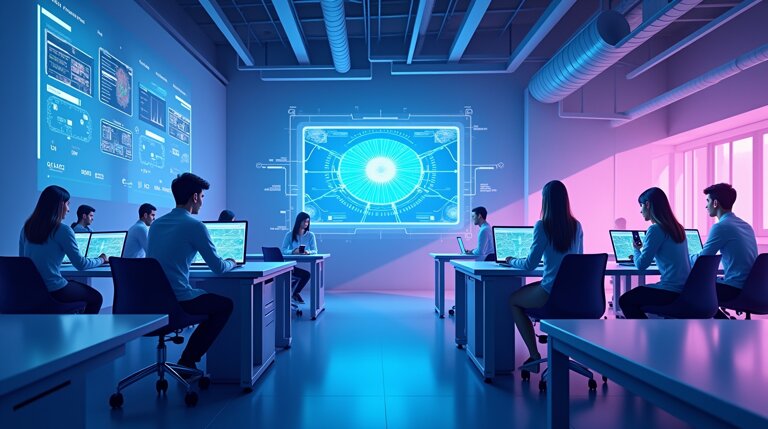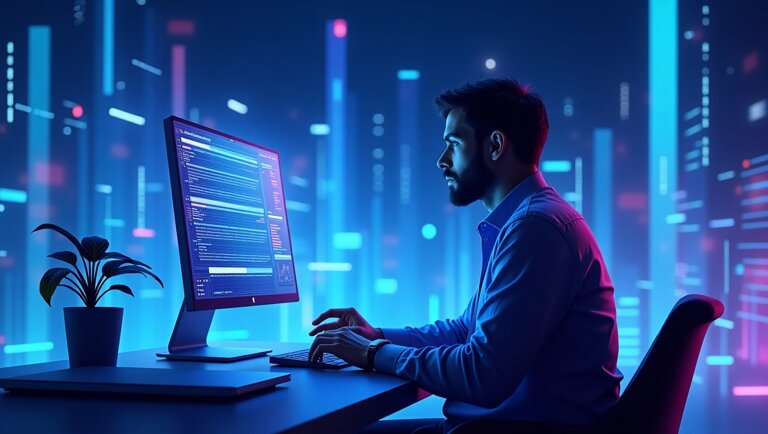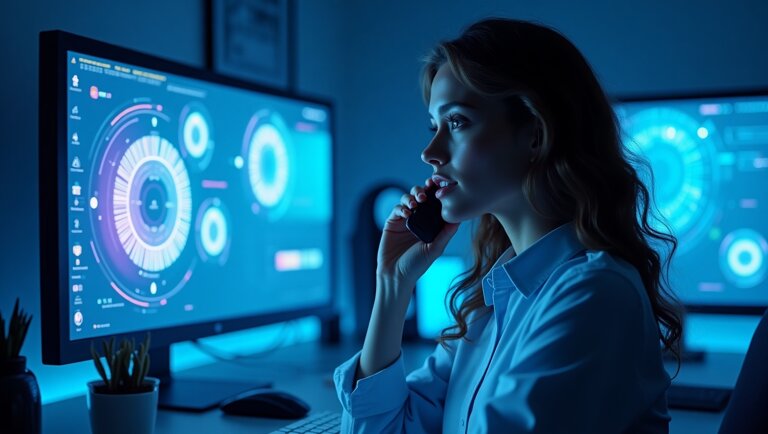Artificial Intelligence (AI) has revolutionized numerous industries, and the Image generation It is one of the areas in which it has shown a significant impact. Thanks to advanced technologies such as deep learning and neural networks, AI is able to create images that not only mimic reality but can also generate original works of art. This phenomenon has opened up new frontiers in the world of creativity, allowing designers, artists and professionals to explore possibilities that were previously unthinkable. Use the Artificial intelligence to create images is becoming more and more common.
The Image generation through AI is not limited to simple graphic manipulations; It involves a complex process in which intelligent algorithms analyze massive amounts of visual data to learn styles, shapes, and colors. This approach has led to the creation of tools that can generate realistic or artistic images in seconds, fundamentally changing the way we conceive of visual production. The Artificial intelligence to create images It therefore offers unprecedented opportunities.
A AI Image Generator offers extraordinary creative possibilities. DALL-E creates photorealistic works, Midjourney excels in artistic compositions, while Stable Diffusion allows for advanced customizations. Leonardo AI specializes in digital art and Canva AI makes graphic design easy for beginners. Each meets different needs in the growing landscape of assisted creativity.
Find out how the Artificial intelligence to create images It can be fascinating and useful for those looking to pursue a career in digital creativity.
The revolution of the AI image generators It has democratized visual creation, allowing anyone to turn ideas into digital art. A Midjourney tutorial can introduce even beginners to this technology, while using DALL-E generate images It delivers surprisingly realistic results with just a few clicks. The key to success lies in the formulation of effective AI prompt for images , which guide the algorithm towards the desired result.
For those who want to experiment at no cost, numerous AI art generator for free They offer basic but powerful features. More experienced users can consult a Stable Diffusion guide for advanced customizations and superior creative control. Modern platforms also allow you to enhance images with AI , optimizing existing photographs or correcting imperfections. Companies are discovering the potential of Create Logos with AI , dramatically reducing design time and costs. The generation of AI commercial images is transforming marketing and advertising, while the ability to convert text to image AI It allows you to visualize complex concepts instantly, opening up new frontiers in visual communication and creative storytelling.
Table of Contents
How AI works in the image generation process
The operation of AI in image generation is mainly based on machine learning models, especially convolutional neural networks (CNNs). These models are designed to recognize patterns and features within images, allowing AI to "learn" from a vast set of data. During the training process, the algorithm analyzes thousands of images, identifying key elements such as shapes, colors, and textures.
Once trained, the model can generate new images by combining the information learned. For example, a model might be able to create an image of a natural landscape by mixing elements from different photographs. This process is not just a simple copy; AI can also apply specific art styles, creating works that reflect influences from famous artists or art movements.
Practical applications of AI in image creation
The practical applications of AI in image creation are many and varied. In the advertising industry, for example, companies are using AI to generate engaging visual content that grabs the audience's attention. Ad campaigns can benefit from personalized images created in real-time, adapting to user preferences and increasing the effectiveness of the message.
In addition, AI finds application in the field of fashion , where designers and brands can use algorithms to create new models and collections. Through image generation, ideas and concepts can be quickly visualized, speeding up the creative process and reducing the costs associated with physical prototyping. Even in the entertainment industry, AI is transforming film and video game production, enabling the creation of stunning visual effects and realistic digital characters.
Benefits and limitations of using AI for image creation
There are many benefits to using AI for image creation. One of the main ones is the speed at which you can generate visual content. In a world where the demand for fresh and original content is constantly growing, AI offers an effective solution to meet these needs.
Additionally, AI can help overcome the limitations of human creativity by proposing combinations and styles that may not be immediately apparent to an artist. However, there are also significant limitations to consider. The quality of the images generated is highly dependent on the quality of the data used to train the model.
If the data is limited or unrepresentative, the resulting images may be unrealistic or even distorted. In addition, there is a risk that the use of AI could lead to a standardization of creativity, with works that all look similar to each other.
Ethics and privacy in the use of AI for image generation
Ethics and privacy are crucial issues in the field of AI and image generation. With AI's ability to create visual content that may look authentic, concerns arise regarding the misuse of such technologies. For example, the creation of deepfakes – videos or images manipulated to make it appear that a person is saying or doing something they never actually did – raises questions about the truth and integrity of visual information.
In addition, there is the problem of intellectual property. Who owns the rights to an image generated by an algorithm? Is it the artist who created the model, the programmer who wrote the code, or the user who used the tool?
These questions require thorough reflection and proper regulation to ensure that the rights of individuals are respected.
Industries where AI for image creation is revolutionizing the market
AI is revolutionizing several industries through the creation of innovative and personalized images. In the health sector, for example, AI is used to analyze medical images such as X-rays and MRIs, improving the diagnosis and treatment of diseases. AI's ability to identify visual abnormalities can lead to faster and more accurate diagnoses.
Even in the architecture and interior design industry, AI is changing the way spaces are designed. Architects can use AI-powered tools to visualize designs in real-time, exploring different aesthetic and functional options without having to create complex physical models. This approach not only speeds up the design process but also allows for greater customization of living solutions.
Tools and platforms available to leverage AI in image generation
There are a number of tools and platforms available to leverage AI in image generation. Among the most well-known is DALL-E, developed by OpenAI, which allows users to create images from textual descriptions. This tool has gained popularity due to its ability to generate unique and amazing artwork.
Other tools include Runway ML and Artbreeder, which offer intuitive interfaces for creating and editing images through image algorithms. These platforms are accessible even to those without advanced technical skills, thus democratizing access to image generation technology. As technology continues to evolve, more innovative tools are likely to emerge in the near future.
Future prospects and developments in the use of AI for image creation
The future prospects for the use of AI in image creation are extremely promising. With continued advances in deep learning technology and image processing, we expect algorithms to become increasingly sophisticated and capable of generating even more complex and realistic visual content. This could lead to new art forms and immersive visual experiences that challenge our current conceptions of creativity.
Additionally, the integration of AI with other emerging technologies such as augmented reality (AR) and virtual reality (VR) could further revolutionize the way we interact with generated images. We envision a future where we can explore virtual worlds created by AI or collaborate with intelligent algorithms to co-create artwork in real-time. However, it will be crucial to address the ethical and legal issues associated with these technologies to ensure responsible and sustainable use of AI in image creation.
A related article that may interest you is "5 reasons why you don't sell" available on this link . In this article, we look at the top reasons why you might be struggling to sell and offer helpful tips for improving your sales strategies. If you're interested in optimizing your sales skills, this article may provide you with interesting insights to consider.
FAQs
What is Artificial Intelligence?
Artificial intelligence is a branch of computer science that deals with creating systems that can perform tasks that usually require human intelligence. These systems can learn, reason, solve problems, and make decisions on their own.
How does artificial intelligence work in image creation?
AI can be used for image creation through the use of algorithms and neural networks. These tools can be trained on large image datasets to learn how to generate new images, edit existing images, or complete missing parts of an image.
What are the practical applications of using artificial intelligence for image creation?
The use of artificial intelligence for image creation has several practical applications, including generating visual content for the entertainment industry, creating digital art, enhancing and correcting images, and generating images for scientific and research purposes.
How can I use AI for image creation?
To use AI for image creation, you can use software and platforms that offer AI-based tools for generating and editing images. In addition, you can train custom AI models using machine learning frameworks and libraries.
What are the challenges in using AI for image creation?
Some of the challenges in using AI for imagery include the quality and reliability of the generated results, the need for large training datasets, computational complexity, and the ethical and legal understanding of the use of AI in the creative realm.




